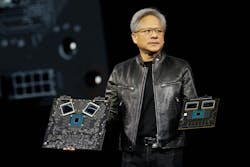Nvidia Expands Collaboration with Industrial Automation Tech Suppliers
Until recently, Nvidia was a technology supplier whose products were largely used in the automation sector primarily for advanced simulation graphics. And that makes sense because Nvidia is well-known for its graphics processing unit technology, better known by the acronym GPU. Because of this, Nvidia has long been a major player in the gaming industry.
But Nvidia has become much more than a GPU supplier, as it has expanded into a full-stack computing company that, for the manufacturing and processing industries, reaches into artificial intelligence, digital twins and robotics.
That’s why you’ve been hearing more and more about industrial automation companies aligning with Nvidia to deliver advanced technologies that enable manufacturing companies to digitally transform and achieve Industry 4.0 goals.
Until Nvidia’s recent conference unleashed a wave of industrial automation-related news, some of the biggest Nvidia news of interest for manufacturers related to the company’s work with:
- Siemens around industrial metaverse development.
- Toyota and Ready Robotics revolving around the use of Nvidia's Isaac Sim environment for easier robot programming.
- Mercedes-Benz deployment of its Mercedes Modular Architecture which relies on digital twins powered Nvidia's Omniverse technology.
- Robot end effector supplier Schunk and Ready Robotics on the use of siimulation to support specification, deployment and re-deployment of automated systems.
Of course, beyond these announcements, there’s also been several automation device related releases featuring embedded Nvidia technology. Just type in Nvidia into the search bar on the automationworld.com site and you’ll quickly see how widespread the use of Nvidia technologies has become in the industrial automation sector.
But apparently, all this news was just a prelude to the avalanche of industrial automation news to come out of Nvidia’s recent conference in March 2024.
To give you an idea of how pervasive Nvidia technology is becoming to industrial automation, here’s a rundown of some of the biggest news to come out of that conference.
First up, Rockwell Automation announced a strategic collaboration with Nvidia to accelerate its next-generation industrial architecture that will impact Rockwell Automation’s portfolio of software, hardware and services. Rockwell Automation plans to integrate Nvidia’s Omniverse Cloud application programming interfaces with its Emulate3D digital twin application. Rockwell says this will enable factory analysis, including operations and simulation, to be quicker and more predictive. As part of this partnership, Nvidia has joined the Rockwell Automation PartnerNetwork, allowing Rockwell Automation customers to access their applications more directly.
Next, Siemens announced that it plans to deepen its existing work with Nvidia around the industrial metaverse. Here, Siemens will add Nvidia Omniverse Cloud programming interfaces to its Xcelerator platform for artificial intelligence-driven digital twin development. At the Nvidia conference, Siemens and Nvidia demonstrated how generative AI is being used to visualize complex industrial data, making photorealism in digital twins possible. As an example, the companies showed how shipbuilder HD Hyundai is using it to develop new ammonia- and hydrogen-powered ships, which can contain more than seven million discrete parts. HD Hyundai is using Nvidia’s and Siemens generative AI technology to unify and visualize these massive engineering datasets interactively.
Siemens also announced that it will release a new product later this year for Teamcenter X, the company’s cloud-based Product Lifecycle Management software, which is part of the Siemens Xcelerator platform. According to Siemens, this new product will provide engineering teams with the ability to create a photorealistic, real-time, and physics-based digital twin to eliminate workflow waste and errors.
Siemens is focusing on the photorealistic renderings enabled by Nvidia’s technology using generative AI to accelerate development tasks that previously took days to complete but can now be done in hours, with engineering data contextualized as it would appear in the real world.
Schneider Electric is working with Nvidia to optimize data center infrastructure to enable edge artificial intelligence and digital twin technologies. Schneider Electric says it plans to introduce the first publicly available AI data center reference designs. These designs will be used to “redefine the benchmarks for AI deployment and operation within data center ecosystems” according to Schneider Electric.
This focus on the use of AI applications in data centers is gaining traction across industries as the need for processing power has surged exponentially.
In the first phase of this collaboration, Schneider Electric will introduce data center reference designs tailored for Nvidia accelerated computing clusters and built for data processing, engineering simulation, electronic design automation, computer-aided drug design, and generative AI applications.
In addition to the data center applications, Aveva, which is a subsidiary of Schneider Electric, will connect its digital twin platform to Nvidia Omniverse, to deliver a unified environment for virtual simulation and collaboration. This integration will reportedly enable collaboration between designers, engineers and other stakeholders to accelerate the design and deployment of complex systems, while helping reduce time-to-market and associated costs.
Teradyne Robotics, which includes the collaborative robot company Universal Robots and autonomous mobile robot company MiR, also announced a collaboration with Nvidia.
As part of this collaboration, Universal Robots has integrated Nvidia accelerated computing into its UR5e cobot platform for faster path planning, which reportedly makes the path planning process 50 to 80 times faster. This application combines Nvidia’s Jetson AGX Orin system-on-module designed for edge AI applications, the cuMotion path planner from the NVIDIA Isaac Manipulator platform and Universal Robots’ new PolyScope X software.
For MiR’s 1200 Pallet Jack, the company is also using Nvidia’s Jetson AGX Orin module. Here, the MiR1200 Pallet Jack combines data from four RGBD cameras for fast and precise pallet handling. Feeding this camera data into the Nvidia Jetson platform fuses the camera data and 3D LiDAR data to detect obstacles in 3D space for fully autonomous navigation.
With all these Nvidia collaborations taking place at major industrial automation companies, you can expect to be hearing a lot more news about the incorporation of Nvidia technology into many more automation products and at many more companies in the near future.




